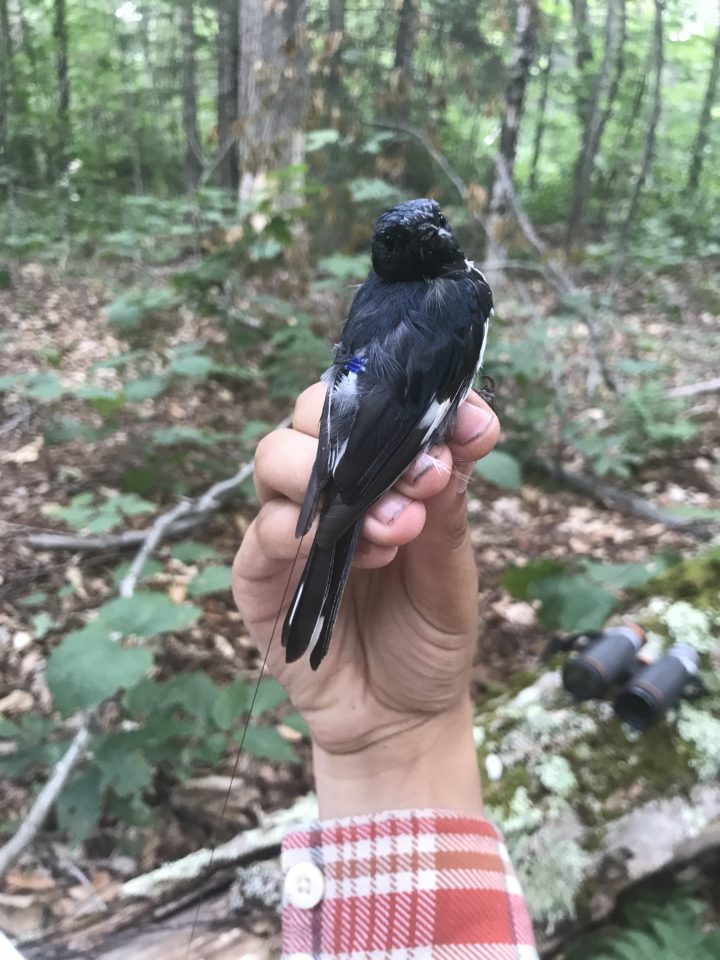A Battle of Wits with a Black-throated Blue Warbler. Amaya Bechler ’24
Diving through chest-high bushes, a branch in each hand, while yelling incoherently—record scratch—yes, that was me over the summer. You may be wondering how I got into that situation. It all started with a Black-throated Blue Warbler named GBYA.
As a bird bander with the Black-throated Blue Warbler field crew last summer at the Hubbard Brook Experimental Forest, my primary job was to capture, band, and take measurements of the warblers to provide essential data for the study. Sometimes, this process proved more challenging than it sounds. GBYA (color bands Green Blue Yellow Aluminum) was a particularly notorious male known for his loud song and evasive habits. He was one such challenge.
It was August 2, and most birds had ceased singing and responding to playback as they wrapped up their breeding season. We still needed to obtain molt measurements and to attach a few more radio-transmitters to birds before they departed for their wintering grounds. The stakes were high. The chances of catching a bird were low. I set up a mist net deep in the forest.
Shortly after starting song playbacks, I noticed a warbler flitting in the canopy. It was GBYA himself! As a returning adult, attaching a radio transmitter to him would be extra valuable. But only if I could catch him.
Two hours passed. I played through the entire library of songs and moved the net a few times. Nestled among the sea of hobblebush, I watched him hop between leaves far from my net. While GBYA never got close, I was desperate. After three hours, I picked up on a pattern. The elusive male would hop near the ground through the very densest bushes, then reappear in the treetops to surveil the net. “One last net set-up,” I promised myself. “One more hour.”
After stringing the net through the densest patch, I retreated to watch the net from behind a tree, and began to play the most aggressive song track. Immediately, GBYA appeared right next to the speaker, mere inches from the net. He was so close, but sat completely still, seemingly assessing the fine mesh net.
Grabbing a branch off the ground, I skirted past the patch of hobblebush to approach him. Waving the stick, I made eye contact with GBYA while only one foot away. It was as if I could see the gears turning in his itty-bitty warbler brain. He dove to the ground and ducked under the net.
He outsmarted me, but I lowered the net to try once more. Sure enough, with playback, GBYA appeared on the same twig. I grabbed a second stick and charged. GBYA seemed to smirk at me as I approached. The second time he flew around the end of the net. The third time he flew over the net.
By the fourth iteration, I was shaking from the adrenaline. He appeared like clockwork, eyeing me expectantly. I crashed through the hobblebush with my two branches. He dropped to scurry under the net again, but this time he finally misjudged. GBYA dove into the gentle threads of the net, captured at last.

When I gently extracted him from the net, it was with a sense of absolute awe. Brilliantly blue and full of life, GBYA looked up at me from between my fingers. In the next 10 minutes, I fitted him with a lightweight radio-transmitter, took a small blood sample for genetic analysis, measured his morphology, and scored his molt. He flew back to his patch of vegetation with verve. I could finally breathe again.
Over the summer, I learned more field skills than I could have imagined. I also collected enough samples to fuel my own research on how the gut microbiome changes from breeding to molt. But ultimately, the privilege of getting to know the warblers so intimately was the most valuable.
On September 28, 2022, GBYA’s radio-transmitter was detected by towers in Massachusetts and Connecticut as he migrated southward. These points contribute information on the migration paths these birds take after departing Hubbard Brook. GBYA is winging his way to the Caribbean. With his tenacity, I like to think he’ll make it back to Hubbard Brook next spring.
—By Amaya Bechler.
